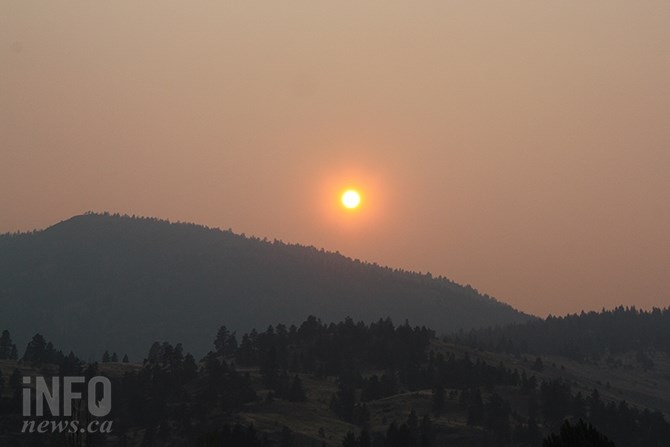
(STEVE ARSTAD / iNFOnews.ca)
September 14, 2020 - 3:30 PM
Wildfire smoking pouring into B.C. from the western U.S. has lowered air quality to the point breathing it is a very high risk to your health.
On a scale of one to 10, air quality in the Okanagan is ranked as 10-plus, while in Kamloops its a 10. The province’s Air Quality Health Index ranks anything from seven to 10 as a high risk to health. A 10-plus ranks the risk at very high.
With smoke drifting in from wildfires fires in Washington sate, Oregon and California, the entire Okanagan is forecast to remain at 10-plus through today, Sept. 14, then drop to 10 overnight and tomorrow.
For Kamloops, while the rating was at 10 this morning, it’s expected to climb to 10-plus later in the day then drop to nine overnight and eight tomorrow, which is still a high health risk ranking.
READ MORE: The air quality index explained

A huge swath of the province is being impacted by wildfire smoke from blazes in the wester U.S. as seen in this map from Environment Canada showing where air quality warnings have been issued.
Image Credit: Environment Canada
The Air Quality Health Index looks primarily at three types of pollutants: fine particulate matter that is made up of microscopic solid or liquid particles, ground level ozone and nitrogen dioxide.
“Wildfire smoke is made up of many gases and small particles,” the province's Air Quality website states. “This can change depending on what is burning, distance from the fire, weather conditions and fire temperature. Fine particulates are usually the main components of wildfire smoke.
“Due to their small sizes, it takes significantly longer than larger particles to be removed from the air. Given the ability to penetrate deep into the respiratory system and even the bloodstream, (fine particulate matter) is considered the biggest public health concern from outdoor air pollution in B.C.”
READ MORE: Smoke from wildfire is like a 'chemical soup,' says fire researcher
The province has issued a Smoky Skies Bulletin for the Southern Interior that suggests, among other things, that people reduce their activity level if they start feeling unwell and people with asthma or other chronic illness carry any rescue medications with them at all times.
While the Okanagan and Kamloops have been hit hard in the past by wildfire fire smoke, especially during intense wildfire seasons in 2017 and 2018, this is some of the most intense smoke.
To put today's air quality into perspective, in August 2018 with wildfires burning in B.C., the air quality in the South Thompson region was a four or moderate, while the North Okanagan was a six and the Central and South Okanagan were at five.
In the summer of 2017, the air quality ranged at times from five to seven, although Kamloops did hit a 10 at least once.
Go here to check the air quality where you live.
To contact a reporter for this story, email Rob Munro or call 250-808-0143 or email the editor. You can also submit photos, videos or news tips to the newsroom and be entered to win a monthly prize draw.
We welcome your comments and opinions on our stories but play nice. We won't censor or delete comments unless they contain off-topic statements or links, unnecessary vulgarity, false facts, spam or obviously fake profiles. If you have any concerns about what you see in comments, email the editor in the link above.
News from © iNFOnews, 2020